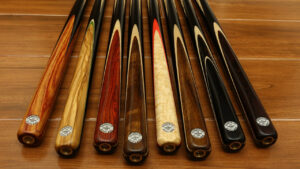Pool Cues

Eight Ball Pool requires a delicate, consistent, and precise acceleration of your cue. There are some basic characteristics of a good cue that I believe are a minimum requirement in playing Eight Ball Pool:
Cue Weight
A cue weighing between 17-19oz. Players with more upper body mass, bigger hands and Popeye arms can probably get away with a heavier cue but I think you can’t go much more than 19oz to play the game properly. Rumor has it that Jimmy White plays with a 21oz cue and if that’s true, it’s explains in part his inability to control the white ball precisely (although his cue action is to blame as well). If your cue weighs much more than 19oz, you will find it difficult to accelerate the cue precisely and play the controlled stuns and screws required. Conversely, if your cue weighs anything below 17oz, you may find the opposite problem of over-accelerating your arm to get any consistent cue ball movement. There are some instances where you can get away with a very light cue. Some of the old vintage cues you see on Ebay weigh 15-16oz but the wood is old growth Ash and Maple that’s well seasoned and lively.
Cue Length
Cue length is a controversial one to recommend. A few factors play a role in what length is good for you including the average distance between your bridge and cueing hand, your height (shorter people should actually have a longer cue), and how you cue (a long backstroke vs a short one). If you tend to have long back swings, a longer cue might be beneficial. If you tend to lock out your bridge arm below vs keeping it bent (what my m8 calls the “broken wing”), then a longer cue is useful to have. I’m 5’9 and although a 57.5″ cue is typical for someone of my height, I tend to stretch my bridge hand out quite far and have a wide distance between my bridge hand cueing hand and so I feel more comfortable with a longer cue. If you don’t know for certain and are looking to acquire a cue, start with the standard specs of 57.5″ in length. As you learn more about cueing, cue action, and body mechanics, you can get a more appropriate cue, or adjust the one you have.
Tip Size
A tip size between 9.5mm and 10.5mm. I think right around 9.8mm is perfect. Tip size is rather important because it determines the contact surface on the cue ball. In Eight Ball Pool, 9.8mm works very well because it allows for accurate cueing at distance and enough contact surface when you are up close playing delicate stun and screw shots. If you use a tip size below 9.5mm you will find it very difficult to get any consistence on long ball potting as you will often get unintended side spin on the cue ball (and miss the pot). Above 10.5mm is too large and it becomes hard to find the right contact point to play precise stun and screw shots. Tip size isn’t a hard and fast rule and if you know what you are doing, experiment and try something different. I do know of at least one player locally who is a very capable century breaker that plays with a 10mm ferrule fitted with an 11mm tip!
Butt Diameter
Butt size is rather important. If you are just starting to play Eight Ball Pool, go with a standard butt size of 29.5mm. If however, you have been playing the game a while, and the basics of your cue action have become second nature (someone having played more than 6 months for example), it’s recommended that you stay with the same butt size as was on your previous cue so that your cue action isn’t dramatically affected. If you have longer than average fingers, or above average height, than a larger butt size may be beneficial. If the butt size is too big for your hand, your hand won’t release properly from the cue during delivery. Generally, when cueing you are supposed to have a soft touch with your cueing hand until after the cue ball has been hit. Think like this when cueing: soft hand feather, soft hand feather, soft hand feather, soft hand backswing, cue ball strike, grip the cue to catch it. The heaving gripping shouldn’t happen until after delivery so a comfortable butt size is important. Conversely, if the butt size is too small, you will find that your wrist starts to twist, turn, and flick. Some wrist flick is useful to have on certain shots, but if your cue butt size is so small it’s happening on every shot, it’s not good.
Bevel or Not?
On a side note, having a bevel or champfer is something I don’t have a clear answer for. The first 5 years I played the game I used a beveled cue. Then I stopped for a few years, acquired a few more cues and now am playing with a round butted cue. I don’t think I would go back to a champfer or bevel now. I actually believe the champfer could cause more problems than it solves but again, I’m not sure I have the right answer yet. If you don’t know for certain yourself, or are just starting out and are ordering a custom made cue, have it sent without a bevel. You can always add it later.
Shaft Taper Characteristics
How a cue shaft is tapered affects how it plays. I think the “milk bottle” taper is how a Eight Ball Pool shaft should be. This is where most of the shaft is thick until the taper becomes more prominent in the last 12 or so inches up to the ferrule. This taper provides the strength and horizontal force for long, straight cueing, and the heavier taper in the last 12 or so inches provides just enough flex to get the easy spin and soft touch when in the short game.
Cue makers tend to have a preferred taper they ship cues out with. Some cue makers base their judgement of the taper based on what they believe the wood needs in order to play. Some like to reduce the cue ball squirt and so thin out the shaft significantly, whereas others like to leave a lot more wood on the shaft and keep the shaft stiff and rigid.
Lower end cues that use less dense Ash and Maple wood tend to ship standard with a very thick shaft. It’s done this way to provide the rigidity but at the cost of cue comfort for the user. Older vintage cues can be made quite a bit slimmer than average as often the wood is more dense and hardened.
American pool cues come with a straight taper where the last 18-24 inches of the shaft are the same diameter. It’s done this way because you can impart more side spin on the cue ball – which is standard practice in American pool. American pool is a top and side spin game, whereas Eight Ball Pool is a screw and stun game. Different shafts are needed to play each game well. For pool I have a Predator shaft (laminated maple, light weight, less squirt), whereas for Eight Ball Pool, I prefer a very dense and stiff Ash or Maple shaft and am not as concerned about squirt.
I hear players talk about how their cue is “lively” but often, it’s just the way the shaft has been tapered. You can take a dead hitting cue, increase the shaft flex by tapering it down on a lathe or by hand, and give it a lot more “life” than it had before.
Ash vs Maple and the Shaft Wood
What’s important is the wood itself. Good cue makers have select Ash or Maple that is well seasoned, aged, dried, and less susceptible to warping. Having straight arrows and lines is a controversial subject and it’s worth some mention. Dense shaft wood with bad arrows will generally play better and with more stiffness than young light weight wood with perfect arrows. Sometimes, lines represent the stiffer part of the tree and so a shaft with many lines can hit well but in other cases too many lines from another tree make the shaft soft and whippy which becomes hard to control and doesn’t play well at all. Don’t be too concerned about arrows or lines if you don’t have a preference or full understanding either way. Just ask the cue maker for dense, stiff, well seasoned wood and leave it to them. Some cue makers suggest that arrows affect sighting and won’t ship you a cue without at least some straight arrows on the top part of the playing cue.
Even if you have a first rate cue, it’s still possible the cue just isn’t right for you. The best way to approach this dilemna, is to go and try some other cues for an extended period of time. If you are lucky enough to have a m8 with a quality cue, ask to borrow it for an hour or so on the practice table. Please don’t “test” a cue on the match table. Your focus is different in a match situation and you don’t get the focused time as you would in practice.
Pool Cues

